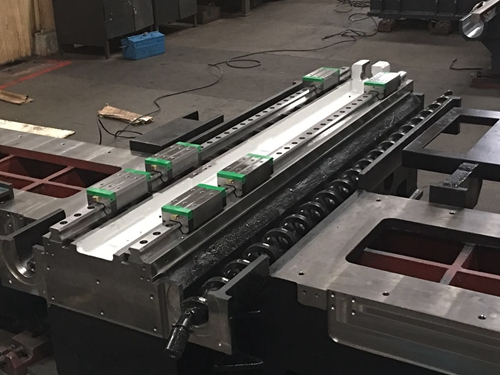
A guideway is one of the important elements of the machine tool. The main function of the guideway is to make sure that the cutting tool or machine tool operative element moves along a predetermined path. The machine tool operative element carries a workpiece along with it. The motion is generally circular for boring mills, vertical lathe, etc. while it is a straight line for lathe, drilling, boring machines, etc.
The purpose of the guideway (or slideway) is to accommodate the axial movement of the machine slides, worktables, and spindles. The guideway also provides the geometric alignment (parallelism, perpendicularity, roll, pitch, and yaw) for the axis. The surface must support the static and dynamic loads (including machining forces) with as little friction as possible, but at the same time dampen the effect of a movable joint on the machine.
The design of machine tool elements is critical in tool engineering. They must withstand against an applied external load. Requirements, functions, and types of guideways are also explained.
i. To have low friction as compared to slideways
ii. Should have uniformity of motion even at slow speeds.
iii. Should have high stiffness if the rolling members are preloaded.
iv. Possibility of using the high velocity of motion.
i. It should be strong
ii. It should process sufficient stiffness
iii. There should be less wear
iv. The pressure distribution should be uniform.
v. It should provide good guidance
vi. There should be less friction.
The guideway configurations or geometries most commonly used are:
1. Round – Limited used on surface grinders as well as feeding spindle bars (e.g. boring mill).
2. Flat – This guideway is used for alignment only – normally outboard from the machine’s spindle. Found on a wide range of machines including grinding machines.
3. Vee – Cylindrical grinders may have vee ways. They are outboard from the grinding wheel and are used primarily for alignment.
4. Dovetail – This guideway is seldom seen on today’s machine tools. However, it has some applications in tool slides (e.g. gang tool slide on a Swiss-type turning machine). It features extremely good rigidity and alignment characteristics. It is an expensive guideway to produce.
5. Box (square/rectangular) – This is a common guideway on machining centers and lathes. It is used in heavy machining (e.g. milling) applications. The box can either be a bolted-on steel rail or an integral part of the machine’s casting. When they are integral, the cast-iron surface is flame or induction heat-treated and then ground and/or hand scraped.
6. Ball or roller – Prepackaged ball and roller packs can be purchased in a variety of sizes and ratings for general application on a wide range of machine guideways.
The guideways are mainly classified according to the nature of friction between contacting surfaces of the operative element :
(a) Guideways with sliding friction
(b) Guideways with rolling friction
The most commonly used shapes of guiding elements of slideways are:
(i) V-type
(ii) Flat type
(iii) Dovetail type
(iv) Circular or cylindrical type.
Antifriction linear motion guideways are used on CNC machine tools to:
(a) Reduce the amount of wear
(b) Improve the smoothness of the movement
(c) Reduce friction
(d) Reduce heat generation.
These are Guideways with Rolling Friction.
Advantages over conventional guideways.
1. Low friction as compared to slideways
2. Uniformity of motion even at slow speeds due to the virtual absence of the stick-slip phenomenon.
3. High stiffness if the rolling members are preloaded, and
4. Possibility of using high velocities of motion.
Following are the advantages of LM Guideways due to which their demand for high precision work is increasing:
1. High Positional Accuracy – When a load is driven by an LM guideway, the frictional contact between load and bed desk is rolling contact. The coefficient of friction is only 1/50 of traditional contact.
2. Long Life with high motion Accuracy – With a traditional slide, errors in accuracy are caused by the counter flow of oil film. Insufficient lubrication causes wear between the contact surfaces. In contrast, rolling contact has little wear, therefore machines can achieve a long life with motion accuracy.
3. High-speed motion is possible with the low driving force LM Guideways have little frictional resistance, only a small force is required to move a load.
4. Equal loading capacity in all directions LM Guideways can take the load in either vertical or horizontal directions.
5. Easy Installation – Installing a Linear Guideway is quite easy. Grinding or Milling the machine surface, following the recommended installation procedure, and tightening the bolts to the required torque can achieve highly accurate linear motion.
6. Easy Lubrication
7. Interchangeability